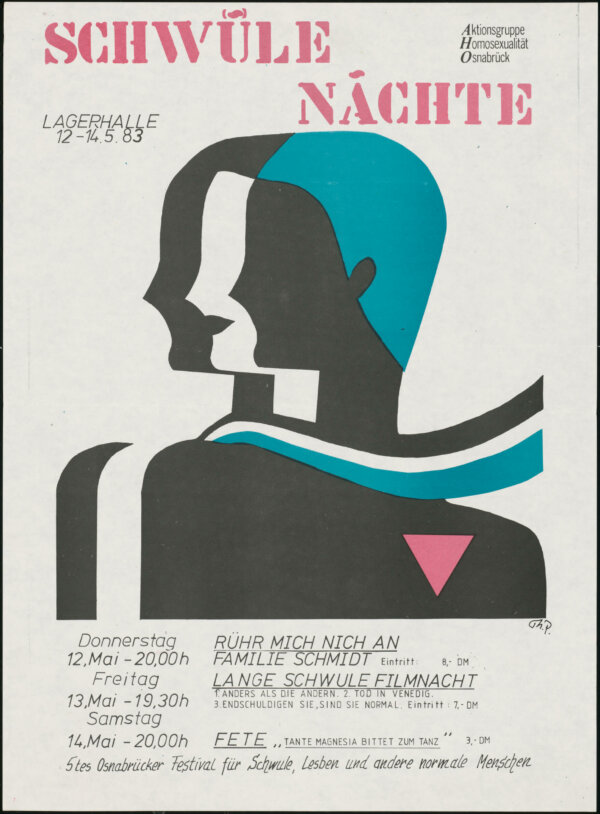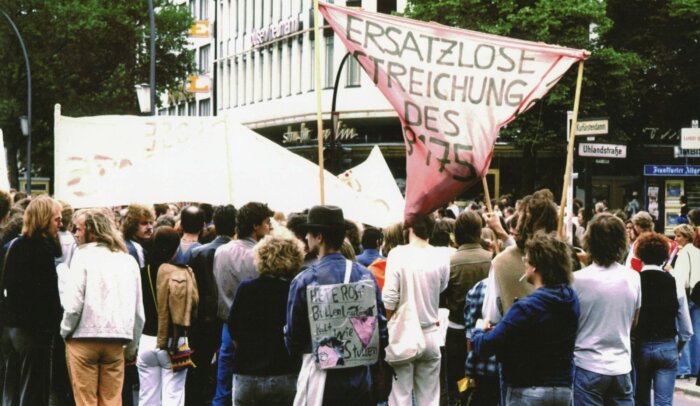The long road to legal reform

It took 123 years before homosexual men in Germany were able to express their sexuality openly without fear of official punishment. Paragraph 175 was not removed from West Germany’s penal code until 1994. Lesbian mothers were denied custody rights for their children right on into at least the 1980s. Queer people still experience discrimination in society today.
Between 1872 and 1994, German legislators and authorities interpreted Paragraph 175 in various ways. The legislation criminalizing homosexual acts was enshrined in Paragraph 175 at the time of the German Empire.
Ȥ175 Reich penal code (1872)
An unnatural sex act committed between persons of male sex or by humans with animals is punishable by imprisonment; the loss of civil rights might also be imposed.«
Excerpt from the text of the law
During the Weimar Republic, the 1920s saw the emergence of a countermovement in big cities. There was a flourishing homosexual scene in clubs and bars, especially in Berlin. But all that changed when the National Socialists came to power. They strengthened Paragraph 175 and saw homosexual men as a threat to their plans to create an “Aryan race.” Within a few weeks, the police shut down all the well-known clubs and bars frequented by gay men, lesbian women, and trans people, including Eldorado in Berlin and Dornröschen in Cologne. On May 6, 1933, the SA ransacked the Institute for Sex Research founded by Magnus Hirschfeld, a founding figure of the first German homosexual movement, who had narrowly escaped an assassination attempt by right-wing extremists in 1920 already.
Pink triangle as an identification mark
As early as 1933, the Nazis began sending men who were persecuted as homosexuals to concentration camps. Many of them were forced to wear patches with pink triangles as a form of identification in the camps. These triangles led to even greater stigmatization as they clearly marked these men out as homosexuals in the camps. They were often treated with particular brutality as a result. And to some extent, they were also exposed to discrimination by other prisoners. On documents like this prisoner registration card for Rudolf Brazda, the pink triangle was often combined with the abbreviations “Homo” or “§175.” Nazi courts convicted about 53,000 men on the basis of Paragraph 175, and it is assumed that about 10,000 men persecuted as homosexuals were detained in concentration camps. Many of them did not survive their imprisonment.
While in Germany, Paragraph 175 only referred to homosexuality between men, in the Austrian part of Nazi Germany, female homosexuality was also a punishable offence. However, quite independently of the possibility of criminal prosecution, lesbian women and queer people faced a particularly high risk of being denounced and of coming under the scrutiny of the Secret State Police (Gestapo) under the Nazi regime because of their sexual orientation and gender identity.
When this happened, a number of other factors also came into play: If, for example, the women concerned had contact with Jews, expressed criticism of the Nazi regime, or were themselves Jewish or belonged to the Sinti or Roma minorities, this was sufficient reason for the Nazis to send them to a concentration camp. Some of the women who were classified as “anti-social elements” or “political prisoners” in concentration camps were lesbians. Laurie Marhoefer explores these issues in greater detail in an essay titled Lesbianism, Transvestitism, and the Nazi State: A Microhistory of a Gestapo Investigation, 1939–1943. Marhoefer researched the story of Ilse Totzke – the Arolsen Archives hold some of the records related to her history. Totzke survived the Ravensbrück concentration camp.



Reinterpretation of the pink triangle
In the 1970s and 1980s, gay activists adopted the pink triangle as a symbol of their movement and reinterpreted it as a positive sign of solidarity.
Raids against gays
Both East and West Germany continued to criminalize homosexuality after the end of the Second World War. While East Germany returned to the provisions that had been in force during the Weimar Republic, West Germany retained the version of Paragraph 175 that had been enacted under National Socialism. Some men who had survived imprisonment in a concentration camp were imprisoned again after 1945. Prejudice against homosexuals was still rife in Germany in the 1950s and 1960s. In 1965, they were referred to as “social parasites” in the “Berliner Abendschau,” a regional TV news program, and those who came out or were outed often lost their jobs. Anyone who had an entry in their criminal record for an infringement of Paragraph 175 had difficulty finding a new job. Raids took place in major cities such as Munich and Berlin, where police tried to catch men in flagrante delicto. The Federal Ministry of Justice estimates that by 1994, some 64,000 men had been convicted under Paragraph 175 in West Germany.
Denial of custody rights to lesbian mothers
After World War II, lesbian women also continued to experience discrimination from many quarters – including the state. An extreme example of this was the denial of child custody rights to women who were known to be lesbians. West German courts continued to take children away from lesbian mothers on this basis right on into at least the 1980s. To protect themselves and their children, some mothers kept their partners secret. Not until this year has an academic study on lesbian life in Rhineland-Palatinate exploring the issue of removing custody become available.
The situation in the GDR
From the late 1950s on, homosexuality was hardly ever punished as a crime in East Germany, and Paragraph 175 was finally abolished in 1968. However, bisexual and homosexual people still suffered discrimination in connection with the legal minimum age for sexual consent. While the age of consent for heterosexual acts was 16, people who entered into homosexual relationships with under 18s continued to be liable to prosecution. This ruling applied to men and women alike. And living a queer life was still taboo at the everyday level too. At the same time, activists were campaigning for self-determination and social change. In the 1970s, they established the Homosexuelle Initiative Berlin (HIB) and organized East Germany’s first national meeting of lesbian women, for example. More than 100 people attended, despite attempts by the police to prevent the event from taking place.
Change in West Germany
In West Germany, the first step towards change came in 1969, when paragraph 175 was revised so that sex between men over the age of 21 was no longer a punishable offence. In the 1970s, gay activists adopted the pink triangle as a symbol of their movement and reinterpreted it as a positive sign of solidarity. Nevertheless, many more years would pass before Paragraph 175 was completely removed from the penal code in 1994, and then another 23 years before all the men convicted under the paragraph were officially pardoned in 2017. This also entitled them to receive €3,000 in compensation and an additional €1,500 per year of imprisonment or part thereof. Only a few people have submitted an application.

